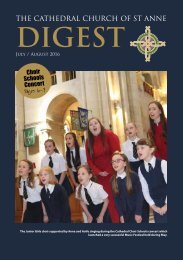You also want an ePaper? Increase the reach of your titles
YUMPU automatically turns print PDFs into web optimized ePapers that Google loves.
Heritage<br />
As it was in the beginning…(xvi)<br />
By Vernon Clegg<br />
In 1894, the Belfast News Letter reported<br />
that at the monthly meeting of the Diocesan<br />
Council in Belfast, which he chaired<br />
on March 7 1894, Bishop Welland revived<br />
the idea of a Cathedral, previously<br />
abandoned in the early 1860s. He was<br />
asked to bring it up at the next meeting.<br />
Press reports don’t mention that he did.<br />
However, on March 20, before that meeting<br />
was due, the Bishop informally presented<br />
to the Select Vestry his proposal<br />
to convert St Anne’s Parish Church into<br />
a pro-Cathedral. Two days later, after a<br />
specially convened meeting, the Vestry<br />
wrote to him rejecting the idea. Their<br />
reasoning was that it would mean handing<br />
over to the Bishop the endowment<br />
specially designed and subscribed for the<br />
maintenance of the Parish Church. Also,<br />
the Parish Church would lose its right to<br />
appoint nominators when selecting future<br />
vicars. Unusually, the meeting wasn’t<br />
chaired by the vicar or his curate (neither<br />
being present) and the chair was taken<br />
by one of the churchwardens.<br />
He wrote again to the Vestry asking for<br />
the matter not to be raised at the Easter<br />
Vestry only days away but that, if it was<br />
raised, he had three points to make: “(1)<br />
that the question of the vicarage is not<br />
essential to the plan; the Vicar might<br />
be retained with his full income and<br />
privilege. (2) that the parish would not<br />
be deprived of the benefit of this parish<br />
church, and (3) that, in my opinion, the<br />
Parish Church would be advanced in<br />
dignity and usefulness”.<br />
At the following Vestry meeting the<br />
chairman, the curate the Rev John H<br />
Mervyn, refused to confirm the minutes<br />
of that meeting saying that it hadn’t been<br />
properly convened. Proper or not, the<br />
Bishop’s reply to the Vestry made it valid.<br />
It left plenty of space between the lines:<br />
“My Dear Sir, I beg to acknowledge the<br />
receipt of the Resolution of St Anne’s<br />
Select Vestry which you have kindly sent<br />
me and which I did not see except in the<br />
public press till today. I am, yours very<br />
sincerely, etc”. While the Bishop would<br />
have been disappointed with the rejection<br />
he was also displeased by the disclosure<br />
to the press of the Vestry’s reaction.<br />
Thomas James Welland (above) was<br />
born in Dublin on March 31 1830, the<br />
son of an architect, was educated at<br />
Trinity College, Dublin and ordained in<br />
1854. He began his ministry as curate<br />
at Carlow, then was vicar of Painstown<br />
in the same diocese, and next, assistant<br />
chaplain of the Mariners’ Church<br />
in Kingstown (now Dun Laoghaire).<br />
He was clerical secretary of the Jews’<br />
Society, Ireland, from 1862 to 1866 and<br />
then assistant chaplain at Christ Church,<br />
Dublin until 1870. He was the incumbent<br />
14<br />
Cathedral Digest




